
Caeciliidae is the family of common caecilians. They are found in Central and South America. Like other caecilians, they superficially resemble worms or snakes.
Gegeneophis ramaswamii, common names Tenmalai caecilian, Tenmalai blind caecilian, Ramaswami's caecilian, and forest caecilian is a species of caecilian. It is endemic to the southern portion of the Western Ghats, India, and is recorded from Kerala and Tamil Nadu. The specific name ramaswamii honours L. S. Ramaswami, an Indian herpetologist.
Praslinia cooperi, or Cooper's black caecilian, is a species of caecilian in the family Grandisoniidae. It is monotypic in the genus Praslinia. It is found on Mahé and Silhouette Islands in the Seychelles. An old reported sighting on its namesake Praslin is not known to be correct.
Caecilia dunni is a species of caecilian in the family Caeciliidae. It is endemic to Ecuador and known from the Amazon basin in Napo and Pastaza Provinces. The specific name dunni honors Emmett Reid Dunn, a prominent American herpetologist. Common name Dunn's caecilian has been coined for it.
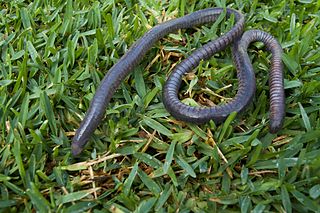
Oscaecilia is a genus of caecilians in the family Caeciliidae. The genus is distributed in southeastern Central America and northern South America, possibly extending into southern Brazil. They are sometimes known as the South American caecilians.
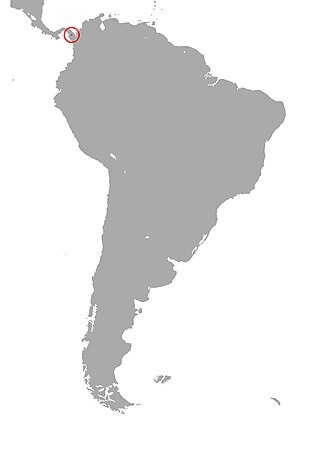
Oscaecilia elongata is a species of caecilian in the family Caeciliidae. It is endemic to Panama. Its natural habitats are subtropical or tropical moist lowland forests, plantations, rural gardens, and heavily degraded former forest.
Oscaecilia hypereumeces is a species of caecilian in the family Caeciliidae. It appears to be endemic to Brazil and is only known from two specimens. The holotype was collected from Joinville in Santa Catarina, although there are some doubts whether this really is its correct origin. Another specimen originates from an unknown locality. Common name Joinville caecilian has been proposed for this species.

Oscaecilia koepckeorum is a species of caecilian in the family Caeciliidae. It is endemic to Peru. Its natural habitats are subtropical or tropical moist lowland forests, plantations, rural gardens, and heavily degraded former forest.
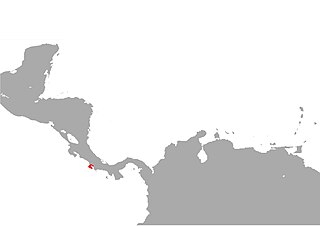
Oscaecilia osae is a species of caecilian in the family Caeciliidae. It is endemic to Costa Rica and is only known from the Golfo Dulce area, on the Pacific Ocean side of Costa Rica. The specific name osae refers to its type locality, the airstrip at La Sirena, being located on the Osa Peninsula. It is also known as the airstrip caecilia or airstrip caecilian.
Oscaecilia zweifeli is a species of caecilian in the family Caeciliidae. It is a poorly known species only known from few specimens: the holotype from the imprecise type locality, "a small creek tributary to Río Mazaruni" in Guyana, one from similarly imprecise Cayenne in French Guiana, and another one from the Nouragues research station in French Guiana. The specific name zweifeli honors Richard G. Zweifel, an American herpetologist. Common names Zweifel's caecilian and tributary caecilian have been coined for it.
Sylvacaecilia is a monotypic genus of caecilian in the family Grandisoniidae. The only species is Sylvacaecilia grandisonae, also known as the Aleku caecilian or Ethiopian caecilian. It is endemic to southwestern Ethiopia and known from the Gambela, Oromia, and Southern Nations, Nationalities, and Peoples' Regions.
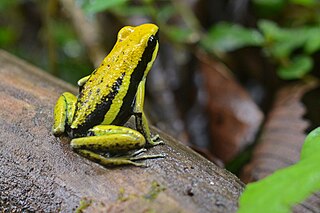
The pleasing poison frog is a species of frog in the family Dendrobatidae endemic to Peru. The specific name bassleri honors Harvey Bassler, an American geologist and paleontologist.
Ichthyophis bernisi, the Indonesia caecilian or Indonesian caecilian, is a species of amphibian in the family Ichthyophiidae. It is endemic to Java (Indonesia). It is only known from the holotype collected from an unspecified location on Java before 1975. The specific name bernisi honors Francisco Bernis Madrazo, a Spanish ornithologist.

Ichthyophis hypocyaneus, the Javan caecilian or marsh caecilian, is a species of amphibian in the family Ichthyophiidae of caecilians, endemic to Java, Indonesia. Until its rediscovery in 2000, it was known only from the 1827 type specimen.

Ichthyophis monochrous, the Western Borneo caecilian or black caecilian, is a species of amphibian in the family Ichthyophiidae. It is endemic to northern Borneo and known from western Kalimantan (Indonesia) and Sarawak (Malaysia), likely occurring also in Brunei. It is a little-known species known from only a few specimens. It presumably inhabits tropical moist forest. Adults are likely subterranean.

Chiasmocleis bassleri is a species of frog in the family Microhylidae. It is found in the Amazon biome of Brazil, Colombia, Ecuador, Peru, and Bolivia. The specific name bassleri honors Harvey Bassler, an American geologist and paleontologist. Common name Bassler's humming frog has been proposed for this species.
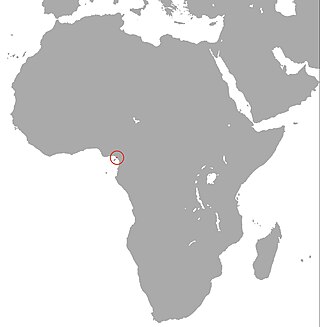
Crotaphatrema bornmuelleri is a species of caecilian in the family Scolecomorphidae. It is endemic to Cameroon. The specific name bornmuelleri honours Joseph Friedrich Nicolaus Bornmüller, a German botanist. Common names Bornmuller's caecilian and Bornmüller's caecilian have been coined for it.
Crotaphatrema lamottei, the Mount Oku caecilian or Lamotte's caecilian, is a species of caecilian in the family Scolecomorphidae. It is endemic to Mount Oku in Cameroon. The specific name lamottei honours Maxime Lamotte, French biologist. There is some doubt whether Crotaphatrema tchabalmbaboensis really is distinct from this species.
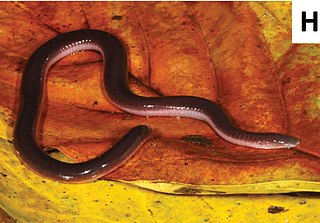
Scolecomorphus kirkii is a species of caecilian in the family Scolecomorphidae. It is known from southern Malawi east of the Shire River, northern Mozambique, and Tanzania ; the known distribution is discontinuous but the species is expected to occur in the intervening areas.
Uraeotyphlus oommeni, sometimes known as the Oommen's caecilian, Oommen's Uraeotyphlus, or Bonnacord caecilian, is a species of caecilian in the family Ichthyophiidae. Within Uraeotyphlus, it belongs to the U. malabaricus group showing no obvious external differentiation between primary and higher-order annuli. This species is endemic to the Western Ghats and only known from its type locality, Bonaccord, Thiruvananthapuram district, southern Kerala. Very little is known about this species known only from a single specimen collected from an imprecise location.













